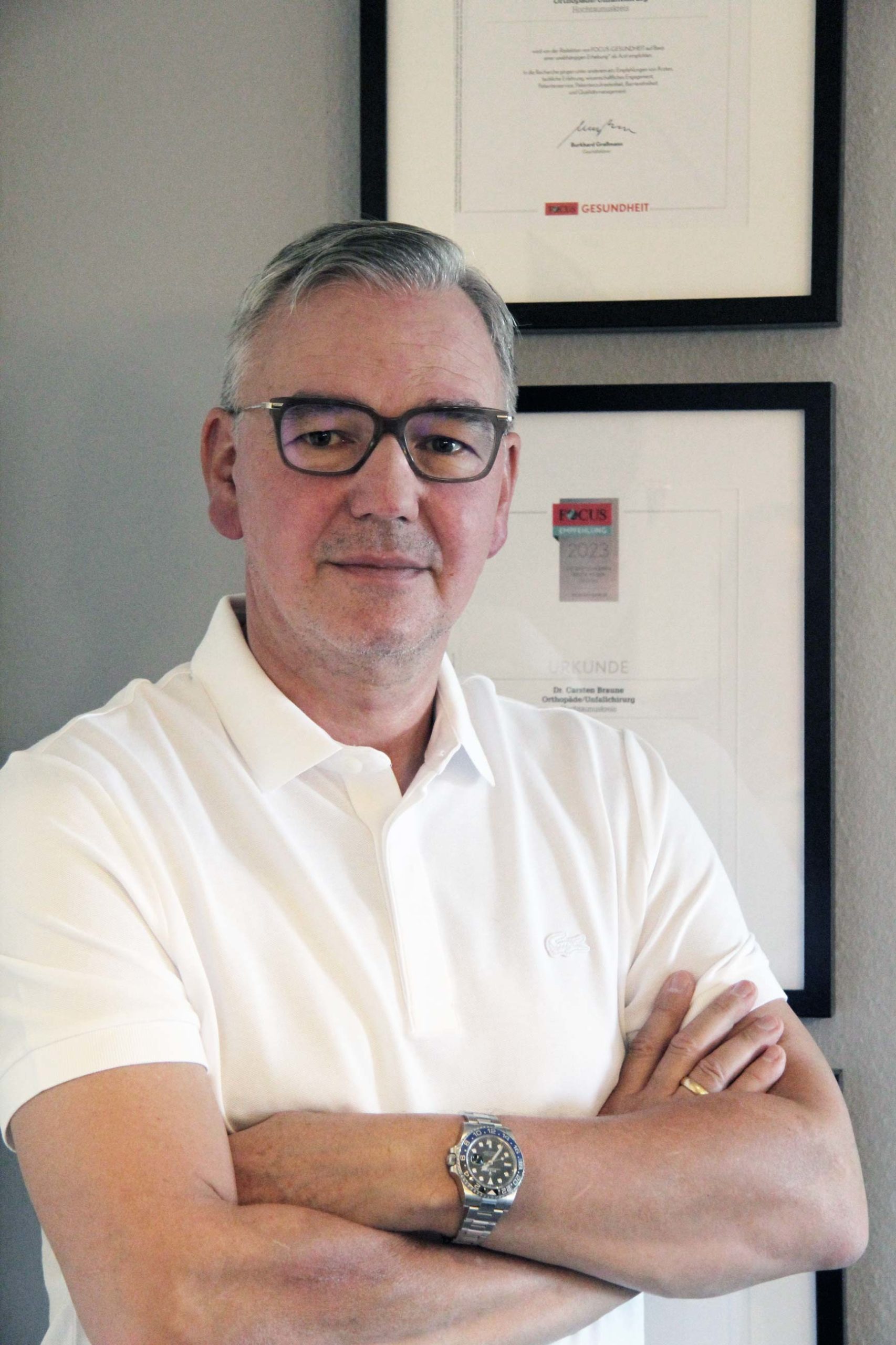Frozen Shoulder
Treatment of frozen shoulder
Opening bottles, blow-drying hair, lifting something - these are all movements that we take for granted in everyday life. For each of these movements, we also need our shoulder. But what if every movement in the shoulder suddenly becomes painful or only possible to a limited extent?
This is exactly what happens with a frozen shoulder. The shoulder pain usually begins abruptly and then occurs more and more regularly, even with everyday movements, until it persists permanently. Eventually, the shoulder stiffens and can hardly be moved.
Thanks to state-of-the-art diagnostics, Dr. Braune recommends individual treatment strategies to his patients and , as an experienced orthopaedic surgeon, is able to perform surgical procedures.
With this long-lasting disease, this often leads to a severe restriction of the quality of life and can also have an adverse effect on the job. Find out here what exactly frozen shoulder is and how it can be successfully treated by a surgeon and joint specialist. You can also read how the therapy can improve your prognosis for frozen shoulder so that you are free of pain and movement restrictions again as quickly as possible.
Definition
What is a Frozen Shoulder?
Frozen shoulder, also called "frozen shoulder" or "adhesive capsulitis", describes an inflammation of the shoulder joint capsule that often leads to shoulder pain and frozen shoulder.
It is caused by inflammation and subsequent fibrosis of the joint capsule, which shrinks the capsule. The newly formed connective tissue constricts the shoulder joint and can lead to the shoulder no longer being able to move at all. This "freezing" is what gives frozen shoulder its name.
Frozen shoulder often occurs between the ages of 40 and 60 and affects women slightly more often than men. It is more common with diabetes mellitus, thyroid disease or metabolic disorders. An injury or other disease of the shoulder can also be the cause.
Make an appointment online now
Therapy
Selection of the appropriate therapy option
After your complaints and medical history have been comprehensively questioned in a medical consultation and the mobility of the shoulder has been checked, a diagnosis can usually already be made. It is also possible to assess the stage of the disease you are currently in. The form of treatment is then selected.
What are the treatment options for frozen shoulder?
In principle, frozen shoulder is a self-limiting clinical picture that can disappear after 12-18 months without external influence. In the initial phase, an attempt can be made to reduce the severity and severity of the clinical picture by means of the oral cortisone step regimen, in which cortisone tablets are taken in decreasing doses.
Often, however, a frozen shoulder lasts much longer or patients continue to struggle with residual symptoms even after it has subsided. In 10-20% of cases, the symptoms even persist permanently. Early treatment can help prevent such complications and relieve you of your limitations due to adhesive capsulitis as quickly as possible.
When is conservative therapy suitable and how does it work?
It helps primarily in the early stages of the disease, when inflammation in particular is responsible for the pain, as it treats mainly local inflammation and swelling.
Our focus in the conservative treatment of frozen shoulder is on treatment using pulsed magnetic field therapy. It works by generating electromagnetic impulses that penetrate the tissue. By modulating the frequency or intensity, pulsed magnetic field therapy can have different effects: The aim is to reduce inflammation and shorten the duration of pain. Pulsed magnetic field therapy also contributes to the recovery of overused muscles in the shoulder area.
It is usually combined with acupuncture, as this has also been shown to alleviate the symptoms of frozen shoulder. Here, certain acupuncture points are treated with very thin needles. Exactly how acupuncture works has not been conclusively explained. One explanation is based on the release of pain-relieving and anti-inflammatory messenger substances at the puncture site. However, it has been proven that acupuncture can also achieve very good results with frozen shoulder.
When is surgery performed and what surgical treatment options are available?
Surgical treatment of frozen shoulder should be considered in particular if the treatment goal has not been achieved conservatively or if the course of the disease is very severe or protracted. Surgical treatment is also necessary if, for example, for professional reasons, it is not possible to wait until the restriction of movement, which may last for months, subsides on its own.
Make an appointment online now
Surgical treatment options for frozen shoulder
Capsule release
One possible treatment is capsular release. In this arthroscopic surgical procedure, parts of the joint capsule, which has thickened as part of the clinical picture, are thinned out with an electrode. The joint capsule is filled with synovial fluid and normally allows the joint surfaces to glide smoothly. However, the persistent inflammatory stimulus in a frozen shoulder causes the joint capsule to stick together, which restricts mobility and is very painful. These adhesions can be loosened by capsular release. The shoulder can then be gently mobilised under an arthroscopic view and anaesthesia.
Synovectomy
Synovectomy is the surgical removal of the joint mucosa (synovium) of a joint. Inflammation of the synovium causes severe discomfort and leads to wear and tear of the joint. A synovectomy can reduce the inflammation and pain and protects the joint, including the cartilage and tendons, from further damage that can result from permanent irritation. A synovectomy is performed arthroscopically. The synovium is removed through small incisions in the skin.
Adhesiolysis
Adhesiolysis aims to mobilise the shoulder joint intraoperatively. During adhesiolysis, the doctor loosens stuck tissue and removes adhesions that restrict the mobility of the shoulder joint. These are made up of connective tissue that is damaged by the persistent inflammation in frozen shoulder. By loosening these glued strands of connective tissue, which are often fused to the capsule, the shoulder becomes freely mobile again through adhesiolysis. They are detached with a scalpel or instruments with an electric current. In this way, arthrosis of the damaged joint cannot progress any further. Adhesiolysis is an arthroscopic operation.
Subacromial bursectomy
Subacromial bursectomy is used when there is very severe bursitis of the bursa under the acromion ("shoulder roof") as part of adhesive capsulitis. This usually prevents bones from rubbing against tendons and ligaments so that inflammation does not occur. However, if it is too inflamed, the bursa may need to be removed. Subacromial bursectomy can thus remove the focus of inflammation and prevent it from spreading to other structures. Since the bursa regenerates relatively quickly after a subacromial bursectomy, the surgical removal also leaves no permanent damage.
Opportunities & Risks
What are the chances and risks of conservative therapy?
Conservative therapy has few side effects and can prevent progression of the disease, especially in the early phase of inflammation. However, it reaches its limits in the case of a persistent reduction in movement.
What are the chances of success of surgical treatment?
The prospects for surgical treatment of frozen shoulder are promising. As soon as a capsule reduction or adhesions are surgically released, the complaints can disappear after a short time. Long-term damage is also prevented. In order to maintain the freedom of movement that has been gained, physiotherapy should be started as soon as possible.
What are the risks of surgery?
- Infection of the operated area
- Post-bleeding
- Scarring (more inconspicuous with arthroscopy)
- Wound healing disorder
- Postoperative adhesion of the tendons
- Injury to surrounding tendons, ligaments or nerves
- Restriction of mobility due to scar tissue
- Recurrence of the complaints
Preparation & Follow-up
How does an operation work?
Surgical procedures on the shoulder are performed under general anaesthesia. Depending on the operation, the procedure can take up to one hour. The arthroscopic surgical technique enables a tissue-conserving procedure and a faster recovery phase.
What happens after the operation?
The affected joint should be rested for the time being after the operation so that the wound can heal well. Cooling can help reduce the swelling.
However, resting is not synonymous with immobilisation. After minimally invasive operations, the shoulder can already be mobilised on the day of the operation; a physiotherapist will show you the appropriate exercises. This mobilisation serves to prevent stiffening of the joint and to prevent the joint capsule from sticking together again. The exercises should be continued regularly after the surgical treatment of adhesive capsulitis under the guidance of a physiotherapist in order to maintain the range of motion achieved through the treatment. A motorised splint may also be used for passive mobilisation.
Make an appointment online now
Does the treatment take place on an outpatient or inpatient basis?
Basically, there is the possibility of being treated as an outpatient or as an inpatient.
After an inpatient admission, a patient is usually discharged two to three days after the operation. Physiotherapy should definitely be continued after discharge in order to restore mobility in the shoulder joint as best as possible.
In the case of outpatient treatment, you can be discharged a few hours after the procedure. Whether this is an option for you can be discussed with the attending doctor.
How long does the regeneration phase last?
This is very individual. The healing process can take a while even after an operation. Even if you can move your shoulder again without pain after a short time, the full range of motion is sometimes only achieved after a few weeks or months.
When will I be fit for work again?
Depending on your occupation, you will be absent for different lengths of time. As a rule, you can return to work after 3-4 weeks, but it can also take 6-12 weeks for physically demanding activities.
When can I do sport again?
Activities that are not hard on the shoulder can often be resumed after 3-4 weeks. Before that, however, you should discuss with your doctor whether your type of sport meets this criterion or whether you should wait a little longer.


